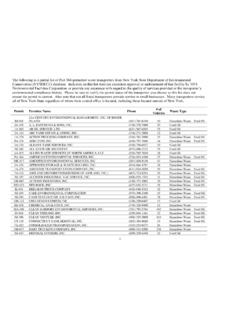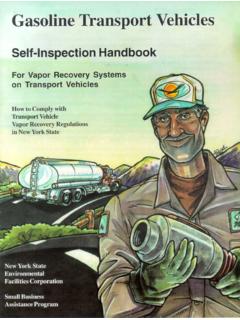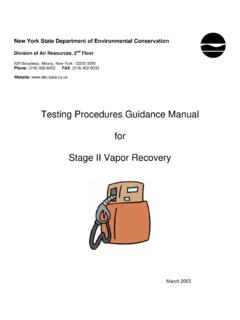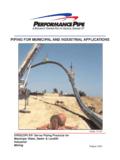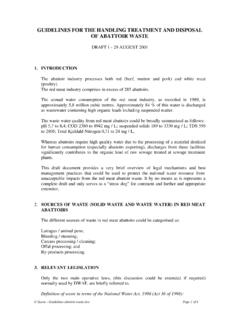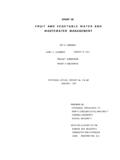Transcription of Common Violations For Typical EPA Regulations
1 Common Violations For Typical EPA Regulations Clean Air Act (CAA) Through the enforcement of the Clean Air Act (CAA), the US EPA seeks to protect and enhance the quality of the nation s air to promote public health and the environment. The CAA addresses permitting programs, criteria pollutants, hazardous air pollutants, mobile sources, acid rain control and global climate protection. This law authorizes EPA to establish National Ambient Air Quality Standards (NAAQS) to protect public health and the environment. Using science-based guidelines, USEPA has established permissible levels for criteria air pollutants including sulphur oxides (SOx), carbon monoxide (CO), lead (Pb), nitrogen oxides (NOx), ozone precursors and particulate matter (PM).
2 Primary standards protect human health while secondary standards address agriculture, property and aesthetics. Chemicals that cause serious health and environmental hazards when released to air are hazardous air pollutants (HAPs) or air toxics. EPA lists 189 HAPs and regulates them under the National Emissions Standards for Hazardous Air Pollutants (NESHAPs). EPA established emission standards based on Maximum Achievable Control Technology (MACT) by pollutant. HAPs include volatile organic chemicals, chemicals used as pesticides and herbicides, inorganic chemicals, and radionuclides.
3 Common Violations and problems under CAA For the most part, a US EPA air inspector will primarily be interested air conditioning and refrigeration, boilers, asbestos, and the title V operating permit. Common Violations and problems include the following: Failure to use properly trained and accredited asbestos personnel Failure to notify EPA of asbestos removal projects and to keep required documentation/recordkeeping Failure to properly dispose of asbestos debris Failure to have CFC leak rate records for chillers and air conditioning units over 50 pounds of charge Failure to have EPA certified technicians for CFC containing air conditioning and refrigeration systems Failure to get boilers permitted with the state agency Failure to apply for Title V operating permit
4 Clean Water Act (CWA) The Clean Water Act (CWA) is the primary federal statute regulating the protection of the nation's waters. The CWA established national programs for prevention, reduction, and elimination of pollution in navigable water and groundwater, including a water quality standards program, a permit program for discharge and treatment of wastewater and storm water, and an oil pollution prevention program. The US EPA protects water resources primarily through the regulatory program reinforcing the Clean Water Act (CWA). The CWA is designed to restore and maintain the chemical, physical and biological integrity of the nation s waters.
5 The CWA seeks to eliminate the discharge of pollutants, including solid waste, biological materials, sewage, chemical wastes and radioactive materials, to surface waters through dredge and fill prohibitions and end-of-the-pipe effluent limits. The water Regulations establish two different permitting programs for wastewater discharges. Facilities that discharge directly to waters ( , rivers, lakes, oceans) of the are covered by the National Pollutant Discharge Elimination System (NPDES) Permitting program. These facilities are known as direct dischargers.
6 Facilities that discharge to municipal wastewater treatment plants are covered by the Pretreatment Program. These facilities are known as indirect dischargers. Another program to consider is the Municipal Separate Storm Sewer System (MS4). The term MS4 does not solely refer to municipally owned storm sewer systems, but rather is a term with a much broader application that can include, in addition to local jurisdictions, State departments of transportation, universities, local sewer districts, hospitals, military bases, and prisons.
7 A MS4 also is not always just a system of underground pipes it can include roads with drainage systems, gutters, and ditches. Common Violations and problems under CWA Water inspectors will primarily be concerned with wastewater discharges, storm water discharges, and any aboveground or underground oil storage containers. Common Violations and problems include the following: As a direct discharge, no or inadequate Storm Water Pollution Prevention Plan (SWPPP) No permit for or noncompliance with wastewater discharges Failure to know about local treatment plant sewer use Regulations and possible prohibited discharges for indirect dischargers No or inadequate secondary containment of storage tanks Improper disposal down floor drains Failure to have Spill Prevention Control Countermeasure (SPCC) in place.
8 Typical records a US EPA inspector may ask to review under the CWA Industrial User permit (IU permit) for discharges to the local municipality s wastewater treatment plant (also called Pubicly Owned Treatment Works (POTW) (indirect discharge). Spill Prevention, Control, and Countermeasure (SPCC) Plan. The plan is to prevent any discharge of oil into or upon navigable waters of the United States or ad-joining shorelines. Industrial storm water permits under the National Pollution Discharge Elimination System (NPDES) program.)
9 NPDES construction storm water permits are also required for any construction activity greater than 1 acre. National Pollution Discharge Elimination System (NPDES) permit for discharging directly to a water body (direct discharge). Emergency Planning & Community Right-To-Know Act (EPCRA) This act, also known as Superfund Amendments and Reauthorization Act (SARA) Title III, was designed to promote emergency planning and preparedness at both the state and local level. It provides citizens, local governments, and local response authorities with information regarding the potential hazards in their community.
10 EPCRA requires the use of emergency planning and designates state and local governments as recipients of information regarding certain chemicals used in the community. SARA Title III, better known as EPCRA, originated from the Comprehensive Environmental Response, Compensation, and Liability Act (CERCLA, or better known as the Superfund law). Like EPCRA Section 304, CERCLA also has hazardous substance release reporting Regulations under CERCLA Section 103; 40 CFR Part 302. Under CERCLA, the person in charge of a facility is required to report to the National Response Center (1-800-424-8802 or ) immediately upon knowledge of a reportable release any environmental release of a listed hazardous substance that equals or exceeds a reportable quantity.
